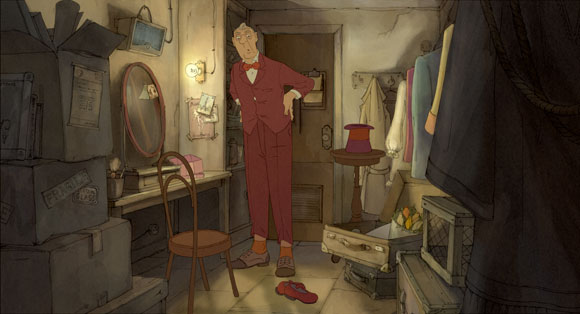The Illusionist

The Illusionist in The Illusionist, directed by Sylvain Chomet. © 2010 Django Films Illusionist Ltd / Cine B / France 3 Cinema, Courtesy of Sony Pictures Classics

Written by Jacques Tati, directed by Sylvain Chomet, The Illusionist traces the changing seasons over the course of a year, as well as the changing professions of a beleaguered magician trying to keep pace with the ungrounded desires of a teenage girl. It is both whimsical and vibrant, grey and sad.
The story is based on a semi-autobiographical manuscript by Tati. In 1959, a magician named Jacques Tatischeff (Tati’s original surname) travels to London, Glasgow and then a small village nearby, where he befriends a young woman, Alice (one of several Lewis Carroll references). She believes he does real magic, as when he replaces her old, tattered shoes with new, red Mary Janes.
In London, he’s upstaged and delayed by The Britoons—a comical take on the Beatles and other boy bands off the era—crooners who play to an inside joke about American culture: seemingly endless curtain calls and encores. Watch as even Buckingham Palace’s change of guard marks how much time passes before Tatischeff hits the stage, with all but two patrons having departed the theatre.
By contrast, the Scottish villagers dancing and throwing back pints of stout (note the Guinness-shaped pint glasses) at the village pub are so poor they manage to scrape together enough funds to buy one lightbulb to replace their gas lamps. Tangentially we understand these people of few means and a slower pace may better appreciate Tatischeff’s humble show—a small table, a hat, a rabbit and a few other tricks up his sleeve.
Alice becomes so enamored with this father figure, she stows away with him to Edinburgh. They check in to a local hotel, where they meet a veritable circus under one roof—acrobats, a ventriloquist and, of course, a chronically depressed clown. They’re the quintessential starving artists barely making do.
Like Fellini, the master of juxtaposition and composition, Chomet contrasts the melancholic lives of the entertainers with Alice’s sense of wonder in her new surroundings. The clown and the ventriloquist in particular are lonely figures, aching for interpersonal contact. She remedies this with some charm and a hearty dinner. Among other slapstick moments leveraging Tatischeff’s towering stature, he cranes his neck about the room under the belief that she’s made a stew of his rabbit!
Each character in every locale of the story is given a radically different appearance from the next: The drunken, kilted Scot with a bloodshot nose—proprietor of the village bar. The wiry, suicidal clown sloshing shot after shot through his trapezoidal mandible. The tipsy Texan with a Cheshire grin (Carroll again?), dropping his car off at the garage where Tatischeff attempts a night job. The amiable acrobats seemingly inspired by the Flying Wallendas.
The film is meticulously crafted in a hand-drawn style reminiscent of Isao Takahata’s masterpiece, Grave of the Fireflies. In a Spartan eighty minutes, layers of visual, narrative and character detail are fluidly conveyed, doubly so for a film that contains no dialogues: Tatischeff’s stride leads from his shoulders down to his weathered, Oxford cap-toes. Alice clops around clumsily in a new pair of white pumps. Warm lights flicker ever-so-slightly; sunrays glow through the windows. Wallpaper is intricately textured, as is the entire frame in a way unlike contemporary three-dimensional computer animation. I feel as though I’m watching a moving watercolor painting.
The film makes considerable use of light, in fact. At a Q&A at the Angelika Theatres in Plano, Texas, Assistant Animator Justin Hall and Production Manager Fiona Hall, intimated that the creative use of light—from lamps, through windows, in and around the staggered architecture of the city—reflects a diverse range of ways sunlight strikes Edinburgh at different times as a result of jutting landscapes produced by ancient volcanic and glacial activity. It was also, they surmise, the intention of the director to lay some emphasis on the connection between light, the medium of cinema and magicians—the earliest celluloid filmmakers.
In brief moments peppered throughout the film, Tatischeff occasionally glances at a black and white photograph of a little girl. As the end credits roll, we sadly discover the girl’s real-life identity. For those who don’t wish to be spoiled, close here knowing that The Illusionist is worth your time and money. For others, a little research on Messr. Tati will reveal the tragic fact of his life as a director consumed by his work.
The Illusionist opens Friday, February 4, at the Angelika Theaters in Dallas and Plano.
 The Illusionist • Dolby® Digital surround sound in select theatres • Aspect Ratio: 1.85:1 • Running Time: 80 minutes • MPAA Rating: PG for thematic elements and smoking. • Distributed by Sony Pictures Classics
The Illusionist • Dolby® Digital surround sound in select theatres • Aspect Ratio: 1.85:1 • Running Time: 80 minutes • MPAA Rating: PG for thematic elements and smoking. • Distributed by Sony Pictures Classics
Dolby and the double-D symbol are registered trademarks of Dolby Laboratories.